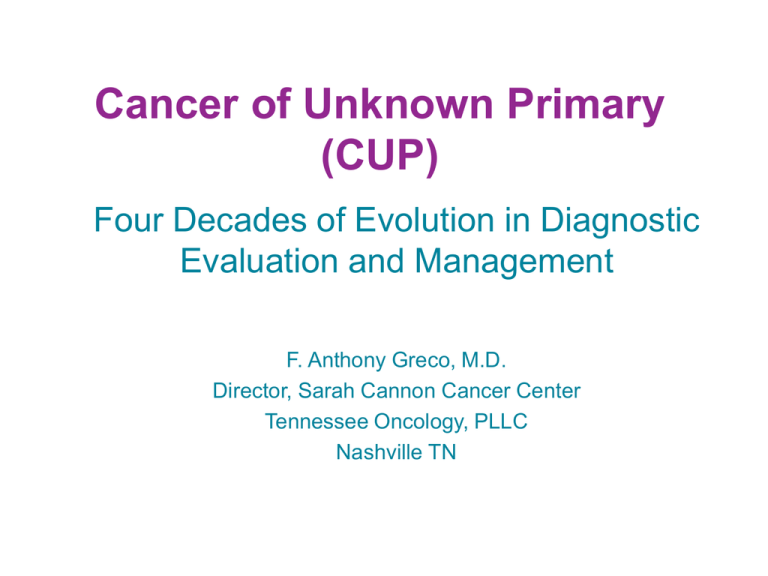
Cancer of Unknown Primary
(CUP)
Four Decades of Evolution in Diagnostic
Evaluation and Management
F. Anthony Greco, M.D.
Director, Sarah Cannon Cancer Center
Tennessee Oncology, PLLC
Nashville TN
Disclosure
• Dr. Greco is on the Speaker’s Bureau for
bioTheranostics.
Four Decades of Changing
Clinical Landscape In CUP
1. 1976-1986: Decade of Recognition of Favorable
Clinicopathologic Subsets
2. 1986-1996: Decade of Improved
Diagnostic Techniques/Testing
Clinical
3. 1996-2006 : Decade of Empiric Chemotherapy
4. 2006-2014 :Decade of Improved Pathologic and
Genetic Diagnostic Technologies and Better
Outcomes for Many CUP patients
Agenda
• Cancer of Unknown Primary (CUP) Background
– Historical Standard of Care: Recognition of favorable
subsets; Empiric chemotherapy CUP Trials
– Improving Clinical Evaluation and finding anatomical
primary sites
• Immunohistochemical (IHC) and Gene
Expression-Based Diagnostic Approaches
– Overview of Clinical Data
– Outcomes-Based Investigations
• A Prospective Outcomes Trial
• Summary
Background: Cancer of Unknown
Primary
• Wide heterogeneity of clinical and pathologic presentations
• About 50,000 patients per year in USA
• Most patients have carcinoma and most of these
adenocarcinomas
• Autopsy studies reveal small clinically undetectable primary
tumor sites in 75% of patients (lung, pancreas, biliary tract,
colorectal, kidney most common, but most tumors
represented)
• Favorable subsets established; represent ~20% of CUP:
–
–
–
–
–
–
–
Squamous cell in the neck Head & Neck Primary
Squamous cell in the inguinal region Anal/Cervical Primary
Adenocarcinoma in the Axilla (women) Breast Primary
Peritoneal carcinoma (women) Ovary/fallopian tube/ primary peritoneal
Extragonadal Germ Cell Tumor Syndrome Germ Cell
Neuroendocrine carcinoma well or poorly differentiated- Many sites
Single metastasis Many sites
Background
Cancer of Unknown Primary (CUP) Definition
Metastatic cancer in the absence of a clinically-detectable anatomicallydefined primary tumor site after an adequate diagnostic evaluation.
CUP diagnosis can be considered a result of diagnostic failure.
Improved clinical diagnostic techniques (CTs, MRI,PET, endoscopies) find
anatomical primary sites more often then in the past.
Many anatomical primary sites are too small to identify despite improved clinical
diagnostic testing.
The pathology (including modern IHC) and genetic testing of CUP biopsies has
enabled a tissue of origin diagnosis in most patients despite an inability to
identify the anatomical primary tumor site.
INITIAL DIAGNOSTIC EVALUATION
Complete history: including detailed review of systems
Complete physical examination: including pelvis
examination, stool for occult blood
Complete blood cell count, comprehensive metabolic panel,
lactate dehydrogenase, urinalysis
Computed tomography scans of chest, abdomen, and pelvis
Mammography in women
Serum prostate-specific antigen in men
Positron emission tomography scan in selected patients
Pathology-including screening immunohistochemistry
marker stains (CK7, CK20, TTF-1, CDX2)
Molecular Cancer Classifier as necessary
Background
• CUP patients within favorable subsets treated with “site-specifc”
therapy have a better prognosis than the group as a whole.
• In the absence of a definitive diagnosis, 80% of patients
(unfavorable prognosis group) with CUP traditionally have been
treated as a single entity, usually with taxane/platinum or
gemcitabine/platinum chemotherapy
• Patient prognosis is poor, with median survivals of
approximately 9 months.
*Reference
Treatment
# of Patients
Median Survival
Greco et al., Oncologist.
2004;9(6):644-52.
Paclitaxel/Carboplatin/
Etoposide followed by
Gemcitabine/Irinotecan
N=111
9.1 months
Greco et al., J Clin Oncol.
2002;20(6):1651-6.
Gemcitabine/Carboplatin/
Paclitaxel
N=113
9.0 months
Piga et al., Br J Cancer.
2004;90(10):1898-904.
Carboplatin/Doxorubicin
/Etoposide
N=102
9.0 months
Hainsworth et al., Cancer J.
2010;16(1):70-5.
Paclitaxel/Carboplatin/
Etoposide
vs Gemcitabine/Irinotecan
N=198
7.4 months
*CUP studies with patient populations greater than 100.
8.5 months
Evolving Role of IHC in Tissue of
Origin Diagnosis in CUP
Lung, adenocarcinoma/large cell
CK7+, CK20-, TTF-1+
Lung, neuroendocrine (small cell/large
cell)
Colorectal
Chromogranin+, Synaptophysin +, TTF-1+
Breast
CK7+, ER+, GCDFP-2+, Mammoglobulin+
Prostate
CK7-, CK20-, PSA+
Ovary
CK7+, ER+, WT-1+
Melanoma
S100+, Melan-A+, HMB45+
Renal
RCC+, Vimentin+, CD10+, PAX-8+
Liver
Hepar 1+, CD10+, CD13+
Germ Cell
PLAP+ and/or OCT-4+
Adrenal
Alpha-inhibin+, Melan-A (A103)+
Thyroid (follicular/papillary)
TTF-1+, Thyroglobulin+
CK7-, CK20+, CDX-2+
Single Tissue of Origin Diagnosed
in 35% of CUP Cancers by IHC
Molecular Cancer Classifiers for CUPPerformed on Biopsies
CancerTYPE ID
Tissue of Origin
Cancer Origin
Test
Real-time RT-PCR
mRNA
Microarray
mRNA
Microarray
miRNA
Tumor Types Classified
28 Main types,
50 Subtypes
15 types
42 types
Specimen
Requirements
FFPE;
Minimum
300-500 cells
FFPE;
6 slides
10 µM thick
FFPE;
3-10 slides
10 µM thick
Sensitivity
87%
88%
86%
Specificity
99%
99%
99%
Platform
Molecular Cancer Classification:
General Approach
In recent years, molecular cancer classification has emerged as a standardized,
objective technique to help identify tumor type in patients with CUP
Concept: neoplasms retain gene expression profile based on cellular origin; this
profile can be exploited to identify tumor type
Molecular Cancer Classification: General Approach
Algorithm
compares sample
to
Reference
Database
Patient biopsy
RNA extraction
Measure
Gene expression
Quantification of differential gene
expression from a patient’s tumor
Predict
Tumor Type
Molecular Classifier
Compare patient profile to gene
expression profile of known tumors
from a reference database
Major Questions regarding the 92gene RT-PCR Assay
1) Accuracy in predicting primary tumor site?
2) What is the evidence that this assay can
accurately identify tumor type in patients
with CUP?
3) Will site-specific therapy based on the
molecular assay diagnosis improve the
outcome of patients with CUP?
Is the 92-gene RT-PCR assay accurate
in predicting primary tumor site?
• Sensitivity = 87% (95% CI, 0.84 to 0.89)
• Accuracy stable in metastatic tumors, high-grade tumors, and
cases with limited tissue
This assay demonstrated excellent performance for classification of a
diverse set of tumor histologies in known tumors
Major Questions regarding the 92gene RT-PCR Assay
What is the evidence that this assay can accurately identify
tumor type in patients with CUP?*
1. Evaluated biopsy specimens in patients found to have latent
primary tumor sites months to years after initial presentation
2. Evaluated biopsy specimens in CUP patients with a single
suspected diagnosis made by IHC
3. Evaluated directed IHC and clinical/histologic findings after
molecular diagnosis known in attempt to confirm molecular
diagnosis
*See – Journal of the National Cancer Institute – 2013,
June 5; 105 (11); 782-90.
1. Accuracy of 92-gene RT-PCR assay in Patients
with Latent Occult Primary Tumors
Molecular Profiling in Unknown Primary Cancer: Accuracy of
Tissue of Origin Prediction
Oncologist 2010; 15 (5); 500-504
Molecular Tumor Profiling Diagnosis In Unknown Primary Cancer:
Accuracy and Ability to Complement Standard Pathology
J Natl Cancer Insti. 2013;105(11):782-90
F. Anthony Greco, David R. Spigel, Denise A. Yardley, Mark G.
Erlander, Xiao-Jun Ma, John D. Hainsworth
F. Anthony Greco, Wayne J. Lennington, David R. Spigel, John D.
Hainsworth
• CUP patients that had latent primary tumors discovered during their
follow-up
• The latent primary tumor site served as the reference known site of
origin
• Original biopsy tissue tested by 92- gene assay (CancerTYPE ID)
• Molecular diagnosis was accurate in 18 of 24 cases
o Sensitivity = 75%
This assay demonstrated high accuracy in CUP patients with latent
primary tumors
2. 92-gene RT-PCR assay Concordance with
suspected IHC diagnosis in CUP Patients
171 specimens from CUP patients referred to SCRI
and tested by this assay
2 – 3 suspected diagnoses after
initial IHC
Single suspected
diagnosis after initial IHC
•
Molecular diagnosis
concordant with IHC
diagnosis in 40 of 52
cases (77%)
43 of 97,
assay prediction
matched 1 of the Dx
•
Clinical features
•
validated molecular
diagnosis prediction •
in 34 of 43 cases
54 of 97, assay
prediction did not
match the IHC Dx
Molecular diagnosis consistent with
clinical features in 41 of 54 cases
Molecular diagnosis prediction
validated with additional IHC and
clinical findings in 26 of 35 cases
(74%)
Correlative study demonstrated 92-gene RT-PCR had high concordance with suspected IHC
diagnoses and provided additional objective diagnostic information when IHC was inconclusive.
This molecular cancer classifier is about 80% accurate in determining the tissue of origin and
complements standard pathology in CUP diagnosis.
3. 92-gene RT-PCR Assay Colorectal
Diagnoses in CUP: Retrospective
Outcomes
Carcinoma of Unknown Primary Site: Outcomes in Patients with a
Colorectal Molecular Profile Treated with Site-Specific Chemotherapy
Jornal Cancer Therory 2012;3;37-43
F. Anthony Greco, Wayne J. Lennington, David R. Spigel, Gauri R.
Varadhachary, John D. Hainsworth
Retrospective analysis of 32 patients
with CUP who were diagnosed by
molecular assay with Colorectal
Cancer (CRC).
29 patients received CRC-specific
regimen.
Median overall survival with CRCspecific regimens was 21 mo.
A Retrospective Study of Treatment Outcomes in Patients with
Carcinoma of Unknown Primary Site and a Colorectal Cancer
Molecular Profile
Clin Colorectal Cancer. 2012; 11(2):112-8
John D. Hainsworth, MD, Catherine A. Schnabel, PhD, Mark G. Erlander,
PhD, David W. Haines III, BS, F. Anthony Greco, MD
Retrospective analysis of 42
patients with CUP who were
diagnosed by CancerTYPE ID with
Colorectal Cancer.
50% of patients treated with CRCspecific regimen had objective
response while only 17% of patients
treated with empiric therapy had an
objective response (p= 0.02).
Median overall survival with CRCspecific regimens was 27 mo.
Responses and survivals are similar to known advanced CRC and
compares favorably to empiric chemotherapy for CUP patients.
IHC Colorectal Diagnosis in CUP:
Retrospective Outcomes
Carcinoma of unknown primary with
gastrointestinal profile: immunohistochemistry
and survival for this favorable subset. Int J CLIN
Oncol 2013 June 28 (Epub ahead of print)
• Retrospective analysis of 74 CUP patients (2004-2010): all had
CDX2+ stain with 34 CK20+,CK7- and 40 irrespective of CK7/CK20
stains.
• All patients received colorectal site-specific chemotherapy
regimens.
• Liver, peritoneum and nodes were common metastatic sites.
• Median survivals exceeded 21 months (37 and 21 months for two
groups).
• CUP patients should have “optimal” IHC to diagnose a colorectal
profile (colorectal tissue of origin) as these CUP patients benefit
substantially from colorectal site-specific therapy.
Responses and survivals are similar to known advanced CRC and
compares favorably to empiric chemotherapy for CUP patients.
Prospective Outcomes Trial
2013; 31(2): 217 – 223
Prospective Outcomes with 92-gene RTPCR assay: Background and Study
Objective
• Objective
– To evaluate the ability of gene expression-based classification with the
92-gene assay to render a tumor type diagnosis in patients with CUP
– To determine the efficacy of treatment regimens based on molecular
assay-predicted site of origin
• Endpoints
– Further evaluation of the accuracy of the molecular assay to identify
responsive vs non-responsive tumor types, and determine outcomes.
– Improvement in overall survival of patients who received molecular
assay-directed, site-specific therapy of at least 30% compared to
previous trials from the same study group (9.1 months to at least 11.7
months). Overall survival compared to 396 patients from a compilation
of 4 CUP trials with contemporary empiric chemotherapies performed
by the same clinical trial network.
Study Design
Design
Eligible patients had a diagnosis of CUP after diagnostic workup on initial
presentation
Patients excluded if they had a treatable CUP syndrome
Patients were treated with standard first-line chemotherapeutic treatment
regimens based on molecular results
CUP Dx
No primary site after standard
clinical, pathological
evaluations
92-gene RT-PCR Assay
Testing
Molecular assay
directed therapy
Hainsworth et al. J Clin Oncol. 2013;31(2):217-23
Patient Flow Diagram
Patients Enrolled
N= 289
Insufficient tissue for assay (n= 37)
Successful Assay
n= 252
Not a treatment candidate (n= 29)*
Received empiric CUP therapy (n= 29)**
Received site-specific therapy
based on assay results
n= 194
Received site-specific therapy
for less responsive tumor types
n= 79
Received site-specific therapy
for more responsive tumor types
n= 115
* Declining performance status, brain metastasis, patient decision
Hainsworth et al. J Clin Oncol. 2013;31(2):217-23
**Unclassifiable result, physician chose to treat with
CUP regimen, non-assay directed therapy
Tumor Classification Predicted by 92gene RT-PCR Assay
• Molecular assay provided a
• Molecular assay provided a
primary site prediction in 98% of primary site prediction in 98% of
the cases
the cases
• 26 different tumor types
predicted
• 26 different tumor types
predicted
‒ Approximately 60% of
patients had tumor types that
are more likely to respond to
site-directed chemotherapy
(median survival >12 months)
‒ 48% of identified tumors
have indicated molecularly
targeted therapies
– Approximately 60% of patients
had tumor types that are more
likely to respond to site-directed
chemotherapy (median survival
>12 months)
– 48% of identified tumors have
indicated molecularly targeted
therapies
Hainsworth et al. J Clin Oncol. 2013;31(2):217-23
Identification of Responsive
Clinical Subsets
•
•
Patients identified by the 92-gene RT-PCR assay to have responsive
tumor types had a statistically significant increase in overall survival
compared to those with less responsive tumor types (p=0.04)
Provides evidence that when more effective therapies are available, this
molecular assay has an even greater impact on patient outcome
Less Responsive
Tumors*
• Biliary tract
• Pancreas
• Gastroesophageal
• Liver
• Sarcoma
• Cervix
• Carcinoid
• Endometrium
• Mesothelioma
• Melanoma
• Skin
• Thyroid
• Head and Neck
• Adrenal
Hainsworth et al. J Clin Oncol. 2013;31(2):217-23
Responsive
Tumors**
• Colorectal
• NSCLC
• Urothelial
• Breast
• Ovary
• Kidney
• Prostate
• Germ cell
• Lymphoma
• SCLC
• Neuroendocrine
*Less Responsive (Median OS ≤12 mo with standard treatment)
**Responsive (Median OS ≥12 mo with standard treatment)
Assay Directed Treatment vs. Empiric Treatment
Historical Control
• 37% increase in overall survival with assay-directed
therapy
Hainsworth et al. J Clin Oncol. 2013;31(2):217-23
Summary
First prospective trial in which molecular cancer classification
has directed site-specific therapy.
The molecular assay provided a primary site prediction in 98%
of cases.
Approximately 60% of patients were predicted to have
responsive tumor types and as treatment options improve,
molecular cancer classification may have an even greater
impact on patient outcome.
Even a correct diagnosis of a relatively unresponsive cancer
type is now unlikely to provide much if any therapeutic benefit.
In this study was there was a 37% increase in overall survival of
the whole group receiving assay-directed therapy.
Gene expression-based classification is recommended as part
of the standard evaluation for selected patients with CUP.
CUP needs to be specifically diagnosed to
offer the best therapy to patients
• Site of origin + Tumor subtype + Biomarker Profile =
– Increasing ability to personalize cancer therapy with a combination of sitedirected cytotoxic therapy and/or molecularly-targeted agents
Glioblastoma
Avastin
Breast
Herceptin, Perjeta,
Tykerb
Skin Basal Cell
Erivedge
Thyroid
Caprelsa
Lung
Avastin, Tarveca, Xalkori
Melanoma
Yervoy, Zelboraf
Pancreas / Neuroendocrine
Affinitor, Sutent
Kidney
Affinitor, Avastin,Nexavar
Sutent, Torisel, Votrient
GIST
Gleevec, Sutent
Sarcoma
Votrient
CRC
Avastin, Erbitux, Stivarga, Vectibix
Prostate
Zytiga
Future Studies
•
•
Future studies will concentrate on defining the genetic aberrations in CUP to explain the
biology of these cancers and to test specific targeted drugs
For example, in this study:
Tumor Type
Molecular Biomarker
Lung
EGFR mutations, EGFR expression, ALK rearrangement,
ALK mutations, KRAS mutations, ROS1 rearrangement,
c‐MET amplification, c‐MET expression, RRM1 expression,
ERCC1 expression, DDR2 mutations, BRAF mutation, PTEN
deletion, PIK3CA mutations
Breast
HER-2 expression, HER-2 amplification, ER/PR, FGFR1
amplification, PTEN deletion, PIK3CA mutations
Colorectal
KRAS mutations, BRAF mutation, NRAS mutations, ERCC1
expression, PTEN deletion, PIK3CA mutations
Gastric
HER-2 expression, HER-2 amplification, c‐MET amplification,
ERCC1 expression, PTEN deletion, PIK3CA mutations
Melanoma
BRAF mutation, C-kit mutation
Basal cell carcinoma
SMO mutation
Medullary Thyroid
RET rearrangement
When should a molecular assay
be ordered in CUP?
• Any patient without IHC patterns diagnostic of a single
primary site or tissue of origin.
• In patients with small biopsy specimens when sufficient
IHC evaluation will not be feasible (e.g., FNAs, pleural
effusions, small needle biopsies).
• In patients with metastasis and a history of 1 or more
previous cancers, when IHC is inconclusive.
• In patients with atypical presentation / clinical
presentation does not match pathologic characterization.
• In any tumor that is very poorly differentiated and there
is question of lineage and/or tissue of origin from IHC.
Impact of Molecular Cancer
Classification in CUP
• The integration of a molecular assay into the
evaluation of CUP patients complements appropriate
IHC/clinical findings and leads to the diagnosis of the
tissue of origin in the majority (90%+) of patients,
even though the anatomical primary site remains
undetectable.
• Site-specific therapy is critical to give many of these
patients the best outcome possible.
• As therapy improves for solid tumors of many types
these therapies may be administered to CUP patients
provided their primary tumor sites or tissues of origin
are recognized.
Changing Clinical Landscape of
CUP over the Decades
CUP in 1976
CUP in 1996
Clinical
Evaluation
•
•
Rudimentary
CT not yet available
•
•
CT scans
Endoscopies
Pathology
•
•
H&E
No IHC
•
Limited IHC
•
Multiple subsets
appreciated with
specific therapy (20%
of all CUP)
Favorable
Subsets
•
NOT appreciated
Treatment
•
•
•
Symptomatic/supportive
No effective therapies
Empiric regimens
•
•
•
Very poor
All patients lumped together
Only a few known solid
tumors had useful therapy
Prognosis
•
•
•
•
Treatment helpful in
favorable subsets
Empiric regimens
Good for favorable
subsets
Empiric regimens
helpful for some
tumors
CUP in 2013
•
•
Can be extensive
CT, PET, MRI, endoscopy,
ultrasound, etc
•
•
Evolving IHC, useful panels
Molecular diagnosis very useful
•
Specific IHC and molecular
diagnosis
Outcome improved with sitespecific therapy
•
•
•
Site-specific therapy
Most CUP patients can have
primary site diagnosed by
molecular dx
•
Improved with site-specific
therapy based upon an accurate
diagnosis of the primary site
Poor for specific tumors with
ineffective therapy
•
Evaluation and Management of
Possible CUP Patient
Clinical Presentation
Initial Clinical/Diagnostic Evaluation and Biopsy
Standard Pathology, Immunohistochemistry Stains
Anatomical Primary Site Not Identified
Favorable Subset CUP
Specific Treatment for Subset
Anatomical Primary Site Identified
Site Specific Therapy
Additional Directed Evaluation
Molecular profile Assay on Selected Tumors (When IHC not diagnostic of a single tissue of origin)
Single Tissue of Origin Diagnosed
Clinical Trial or
Site Specific Therapy
Single Tissue of Origin Not Diagnosed
Clinical Trial or
Empiric Therapy










